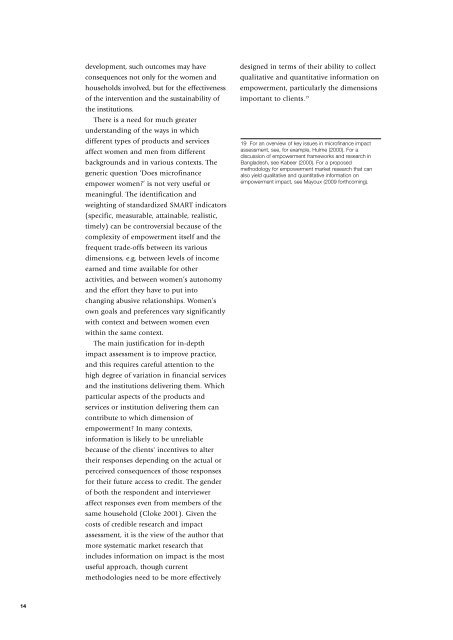Gender and rural microfinance: Reaching and empowering ... - IFAD
Gender and rural microfinance: Reaching and empowering ... - IFAD
Gender and rural microfinance: Reaching and empowering ... - IFAD
You also want an ePaper? Increase the reach of your titles
YUMPU automatically turns print PDFs into web optimized ePapers that Google loves.
development, such outcomes may have<br />
consequences not only for the women <strong>and</strong><br />
households involved, but for the effectiveness<br />
of the intervention <strong>and</strong> the sustainability of<br />
the institutions.<br />
There is a need for much greater<br />
underst<strong>and</strong>ing of the ways in which<br />
different types of products <strong>and</strong> services<br />
affect women <strong>and</strong> men from different<br />
backgrounds <strong>and</strong> in various contexts. The<br />
generic question ‘Does <strong>microfinance</strong><br />
empower women?’ is not very useful or<br />
meaningful. The identification <strong>and</strong><br />
weighting of st<strong>and</strong>ardized SMART indicators<br />
(specific, measurable, attainable, realistic,<br />
timely) can be controversial because of the<br />
complexity of empowerment itself <strong>and</strong> the<br />
frequent trade-offs between its various<br />
dimensions, e.g. between levels of income<br />
earned <strong>and</strong> time available for other<br />
activities, <strong>and</strong> between women’s autonomy<br />
<strong>and</strong> the effort they have to put into<br />
changing abusive relationships. Women’s<br />
own goals <strong>and</strong> preferences vary significantly<br />
with context <strong>and</strong> between women even<br />
within the same context.<br />
The main justification for in-depth<br />
impact assessment is to improve practice,<br />
<strong>and</strong> this requires careful attention to the<br />
high degree of variation in financial services<br />
<strong>and</strong> the institutions delivering them. Which<br />
particular aspects of the products <strong>and</strong><br />
services or institution delivering them can<br />
contribute to which dimension of<br />
empowerment? In many contexts,<br />
information is likely to be unreliable<br />
because of the clients' incentives to alter<br />
their responses depending on the actual or<br />
perceived consequences of those responses<br />
for their future access to credit. The gender<br />
of both the respondent <strong>and</strong> interviewer<br />
affect responses even from members of the<br />
same household (Cloke 2001). Given the<br />
costs of credible research <strong>and</strong> impact<br />
assessment, it is the view of the author that<br />
more systematic market research that<br />
includes information on impact is the most<br />
useful approach, though current<br />
methodologies need to be more effectively<br />
designed in terms of their ability to collect<br />
qualitative <strong>and</strong> quantitative information on<br />
empowerment, particularly the dimensions<br />
important to clients. 19<br />
19 For an overview of key issues in <strong>microfinance</strong> impact<br />
assessment, see, for example, Hulme (2000). For a<br />
discussion of empowerment frameworks <strong>and</strong> research in<br />
Bangladesh, see Kabeer (2000). For a proposed<br />
methodology for empowerment market research that can<br />
also yield qualitative <strong>and</strong> quantitative information on<br />
empowerment impact, see Mayoux (2009 forthcoming).<br />
14

















